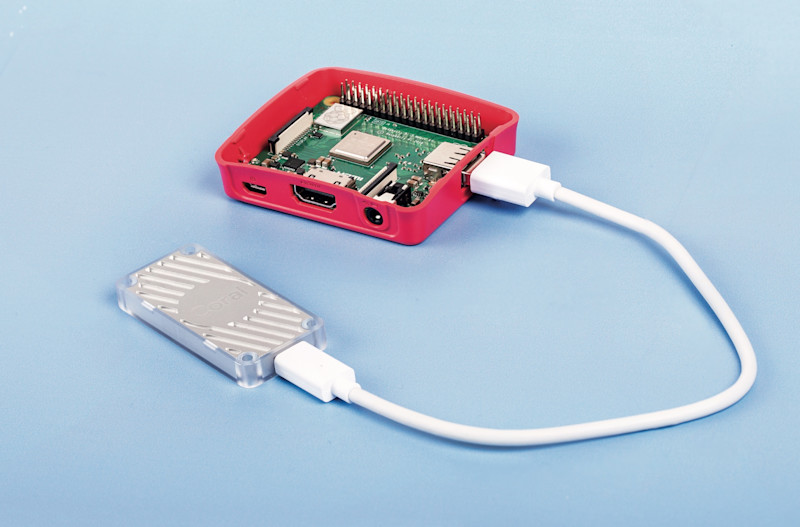6.8 KiB
| comments | description | keywords |
|---|---|---|
| true | Guide on how to use Ultralytics with a Coral Edge TPU on a Raspberry Pi for increased inference performance. | Ultralytics, YOLOv8, Object Detection, Coral, Edge TPU, Raspberry Pi, embedded, edge compute, sbc, accelerator, mobile |
Coral Edge TPU on a Raspberry Pi with Ultralytics YOLOv8 🚀

What is a Coral Edge TPU?
The Coral Edge TPU is a compact device that adds an Edge TPU coprocessor to your system. It enables low-power, high-performance ML inference for TensorFlow Lite models. Read more at the Coral Edge TPU home page.
Boost Raspberry Pi Model Performance with Coral Edge TPU
Many people want to run their models on an embedded or mobile device such as a Raspberry Pi, since they are very power efficient and can be used in many different applications. However, the inference performance on these devices is usually poor even when using formats like onnx or openvino. The Coral Edge TPU is a great solution to this problem, since it can be used with a Raspberry Pi and accelerate inference performance greatly.
Edge TPU on Raspberry Pi with TensorFlow Lite (New)⭐
The existing guide by Coral on how to use the Edge TPU with a Raspberry Pi is outdated, and the current Coral Edge TPU runtime builds do not work with the current TensorFlow Lite runtime versions anymore. In addition to that, Google seems to have completely abandoned the Coral project, and there have not been any updates between 2021 and 2024. This guide will show you how to get the Edge TPU working with the latest versions of the TensorFlow Lite runtime and an updated Coral Edge TPU runtime on a Raspberry Pi single board computer (SBC).
Prerequisites
- Raspberry Pi 4B (2GB or more recommended) or Raspberry Pi 5 (Recommended)
- Raspberry Pi OS Bullseye/Bookworm (64-bit) with desktop (Recommended)
- Coral USB Accelerator
- A non-ARM based platform for exporting an Ultralytics PyTorch model
Installation Walkthrough
This guide assumes that you already have a working Raspberry Pi OS install and have installed ultralytics and all dependencies. To get ultralytics installed, visit the quickstart guide to get setup before continuing here.
Installing the Edge TPU runtime
First, we need to install the Edge TPU runtime. There are many different versions available, so you need to choose the right version for your operating system.
| Raspberry Pi OS | High frequency mode | Version to download |
|---|---|---|
| Bullseye 32bit | No | libedgetpu1-std_ ... .bullseye_armhf.deb |
| Bullseye 64bit | No | libedgetpu1-std_ ... .bullseye_arm64.deb |
| Bullseye 32bit | Yes | libedgetpu1-max_ ... .bullseye_armhf.deb |
| Bullseye 64bit | Yes | libedgetpu1-max_ ... .bullseye_arm64.deb |
| Bookworm 32bit | No | libedgetpu1-std_ ... .bookworm_armhf.deb |
| Bookworm 64bit | No | libedgetpu1-std_ ... .bookworm_arm64.deb |
| Bookworm 32bit | Yes | libedgetpu1-max_ ... .bookworm_armhf.deb |
| Bookworm 64bit | Yes | libedgetpu1-max_ ... .bookworm_arm64.deb |
Download the latest version from here.
After downloading the file, you can install it with the following command:
sudo dpkg -i path/to/package.deb
After installing the runtime, you need to plug in your Coral Edge TPU into a USB 3.0 port on your Raspberry Pi. This is because, according to the official guide, a new udev rule needs to take effect after installation.
???+ warning "Important"
If you already have the Coral Edge TPU runtime installed, uninstall it using the following command.
```bash
# If you installed the standard version
sudo apt remove libedgetpu1-std
# If you installed the high frequency version
sudo apt remove libedgetpu1-max
```
Export your model to a Edge TPU compatible model
To use the Edge TPU, you need to convert your model into a compatible format. It is recommended that you run export on Google Colab, x86_64 Linux machine, using the official Ultralytics Docker container, or using Ultralytics HUB, since the Edge TPU compiler is not available on ARM. See the Export Mode for the available arguments.
!!! Exporting the model
=== "Python"
```python
from ultralytics import YOLO
# Load a model
model = YOLO('path/to/model.pt') # Load a official model or custom model
# Export the model
model.export(format='edgetpu')
```
=== "CLI"
```bash
yolo export model=path/to/model.pt format=edgetpu # Export a official model or custom model
```
The exported model will be saved in the <model_name>_saved_model/ folder with the name <model_name>_full_integer_quant_edgetpu.tflite.
Running the model
After exporting your model, you can run inference with it using the following code:
!!! Running the model
=== "Python"
```python
from ultralytics import YOLO
# Load a model
model = YOLO('path/to/edgetpu_model.tflite') # Load a official model or custom model
# Run Prediction
model.predict("path/to/source.png")
```
=== "CLI"
```bash
yolo predict model=path/to/edgetpu_model.tflite source=path/to/source.png # Load a official model or custom model
```
Find comprehensive information on the Predict page for full prediction mode details.
???+ warning "Important"
You should run the model using `tflite-runtime` and not `tensorflow`.
If `tensorflow` is installed, uninstall tensorflow with the following command:
```bash
pip uninstall tensorflow tensorflow-aarch64
```
Then install/update `tflite-runtime`:
```
pip install -U tflite-runtime
```
If you want a `tflite-runtime` wheel for `tensorflow` 2.15.0 download it from [here](https://github.com/feranick/TFlite-builds/releases) and install it using `pip` or your package manager of choice.